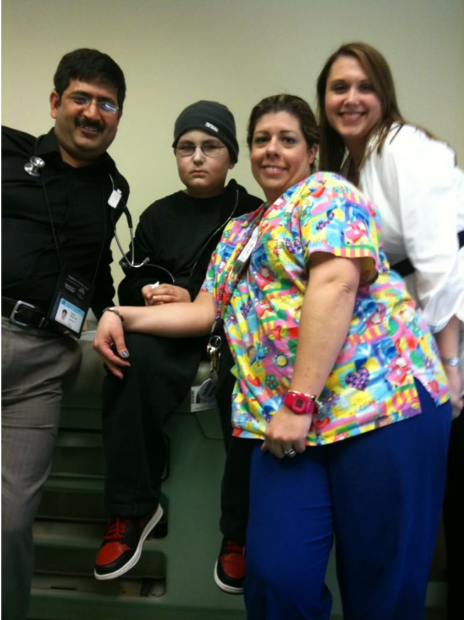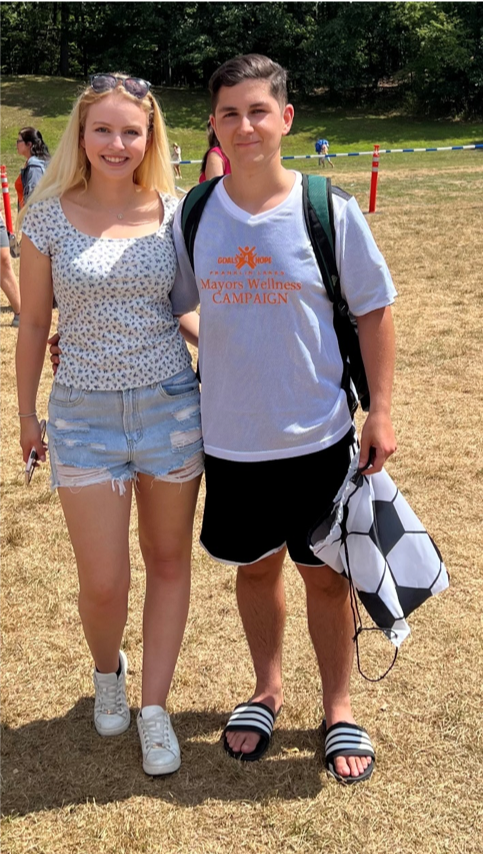"Use my experience as a beacon of hope. If a kid who grew up in hospitals, was bullied, fell behind in school, and has 50% lung capacity can survive, workout, and be happy fifteen years later, so can you."
 James with some of his team during treatmentJames AzarianAs part of Pediatric Cancer Awareness Month, MY HERO got in touch with a (now grown up) pediatric cancer survivor, James Azarian, to share his story and ask for his advice to children across the globe that may be facing similar challenges.
James with some of his team during treatmentJames AzarianAs part of Pediatric Cancer Awareness Month, MY HERO got in touch with a (now grown up) pediatric cancer survivor, James Azarian, to share his story and ask for his advice to children across the globe that may be facing similar challenges.
In third grade, James Azarian was diagnosed with Stage IV Lymphoblastic T-cell Non-Hodgkins Lymphoma. What followed was two grueling years of treatments, including intrathecal chemotherapy, IV and oral chemotherapy medication. Being in and out of hospital to undergo these treatments caused him to miss the end of third grade, all of fourth, and most of fifth, and he quickly fell behind in his studies. Though he remembers little about being diagnosed, as he was too young to fully understand what was happening, James did recall feeling lonely having been taken out of school and described the treatments as ‘brutal.’ After going through seemingly endless treatments, James finally went into remission. Ready to take on the challenges that came with going back to school after almost two years off, James returned at the start of sixth grade, only to be diagnosed with a rarer form of leukemia, Acute Myeloid Leukemia (AML), later that year.
What made James’ second diagnosis so rare, was the fact that the cancer was found in his B-cells, rather than the T-cells in which the first cancer was found. In most cases, when relapse happens, the new cancer is often found in the same cells as the previous cancer. To have it change from one to the other as James’ did is called a ‘lineage switch,’[1] and he was the 34th person on record globally to have this happen to them. Because of this, doctors were unsure of how to treat James at first, though eventually determined that he would need radiation therapy alongside a bone marrow transplant. However, even with the transplant, James was only given a 10% chance of survival, as they did not expect his lungs to handle the radiation.
Within weeks of hearing of James’ need for a transplant, Bergen West Pediatrics in Wyckoff, New Jersey arranged a bone marrow drive, to which 600 people from James’ community attended to be tested to see if they were a match for James. Although no matches were found quickly enough for James, their efforts increased the chances of finding donors for other people across the globe. After some waiting for a donor, a match for James was finally found.
On the 15th December 2010 at Columbia Hospital, James had the bone marrow transplant. Whilst he assumed it was an operation, James was told that the transplant would occur by infusing blood cells into his body via a blood transfusion. James said he was ‘used to being hooked up to drips,’ but remembers feeling extremely tired after the transplant, just as doctors warned he would. One of the most trying parts of a bone marrow transplant is the risk of ‘Graft versus Host Disease,’ which is similar to the body rejecting a donated organ. There are many forms of this disease and James contracted almost all of them, causing his heart to fail and sending him into cardiac arrest. That night, James’ parents were advised by doctors to start thinking about funeral arrangements, as it was unlikely that he would make it through the night.
However, seven days later, James woke up and began to feel much better. He has been cancer free ever since.
 James with his fiance Kimberly 2022James AzarianThe recovery process was long, and James still had many challenges to face. To this day, he has residual health complications and his lungs work at 50% capacity. When he returned to school, after missing the best part of six years, James found it difficult to acclimatize to being around his peers again; he felt that he was perceived as ‘the boy with cancer’ that received special treatment and should’ve been left behind rather than trying to catch up. He struggled with a lot of the content, but also more general skills such as time management, studying, concentration and motivation. To the surprise of this school staff and peers, he persevered and was accepted into his first choice University (Monmouth University) and graduated in Spring 2021 Magna Cum Laude with a BA in Real Estate. Against all odds, James overcame his adversity and is now well on his way to achieving his dreams.
James with his fiance Kimberly 2022James AzarianThe recovery process was long, and James still had many challenges to face. To this day, he has residual health complications and his lungs work at 50% capacity. When he returned to school, after missing the best part of six years, James found it difficult to acclimatize to being around his peers again; he felt that he was perceived as ‘the boy with cancer’ that received special treatment and should’ve been left behind rather than trying to catch up. He struggled with a lot of the content, but also more general skills such as time management, studying, concentration and motivation. To the surprise of this school staff and peers, he persevered and was accepted into his first choice University (Monmouth University) and graduated in Spring 2021 Magna Cum Laude with a BA in Real Estate. Against all odds, James overcame his adversity and is now well on his way to achieving his dreams.
When asked about the figures in his life that helped him through such trying years, James told MY HERO that his mother was his ‘caretaker and advocate,’ explaining that ‘She never gave up, and always kept [him] in a positive space.’ She was a strong believer that with positivity comes positive results, and constantly reminded James of their motto: Positive thoughts only. She wouldn’t allow anyone in James’ room unless they could maintain a positive attitude; even doctors couldn’t deliver bad news in his room. His Dad visited every day possible (when his work schedule permitted), bringing James his favorite food and telling him ‘crazy stories’ to try and make him laugh and lift his spirits. His siblings also did the best they could to support their brother, visiting when their school schedules allowed and calling when it didn’t.
In the time he missed school James’ fourth-grade teacher, Laura Nietzer, would visit him almost daily, encouraging him in his studies, and showing faith in him when few others did. On days when he was too sick to do work, she would read to him and try to engage him as much as he could manage, and if he was sleeping, she sat and kept his mom company. About Laura, James said, “It’s important to have someone in your life that truly believes in you as an individual […] and [besides my family,] Laura Nietzer was that person. I will forever be grateful to her.”
James’ oncologist, Doctor Michael Weiner, was also a significant figure in his support network. Like James’ mom, Doctor Weiner always remained positive, and never made James feel ‘like a sick kid.’ He gave him hope and remains a good friend of the family now.
Also still in contact with James and his family, is the donor that provided the bone marrow for his treatment. The 34-year-old (at the time) woman from Germany was present at his High School graduation and hopes to attend his Masters Graduation from NYU in a year’s time. Without her donation, it is not likely that James would have survived.
The team that worked with James at Columbia Hospital was also imperative in maintaining his mental well-being, with the Hope and Heroes Pediatric Cancer Foundation providing holistic remedies such as essential oils, massage and exercise therapies, aiming to ease the pain that came with the treatments. Child Life Specialist, Melissa, encouraged James’ love of soccer and would bring him a ball to kick around whenever possible. James remembers Ria (whom oversaw the finding of his bone marrow donor) being a never-ending source of positivity and laughter, and her bright clothes making her look as though she ‘stepped out of a children’s book.’ James also notes that Karen, Jane, Danielle and Terry (all members of his team at Columbia Hospital) were key figures in his recovery.
James’ story is full of heroes: himself, of course, persevering and exercising the necessary determination to achieve way beyond what most expected of him, and pursuing his dreams in spite of his shortcomings; his family, for remaining positive and building James up, even in the darkest of times; Laura, who went above and beyond what is expected of any teacher, and encouraged James to believe in himself as much as she did; the community that rallied to find a donor; the donor that, without hesitation, literally gave a part of themselves to help another across the globe; and the countless medical staff that helped navigate James and his family through his journey to health.
MY HERO asked James, “Having overcome adversity in such an incredible way yourself, what advice might you give to others who are experiencing anything similar to what you went through?” His response was this:
“The advice I would give to others who have gone or are going through similar traumas at a young age, would be to never give up hope. The short-term experiences will be difficult, but you must find a way to pursue your happiness and never give up. When I was in the hospital strapped to tubes and isolated to a room with lack of human interaction, I still tried to find happiness. For me this came through expressive forms such as building Lego, playing video games, or watching movies. It is important to maintain some type of humanity and not lose your childhood due to this traumatic life experience. There are many adults that are successful, happy, and healthy who survived pediatric cancer, and you cannot let this vile disease win. No matter what your diagnosis is, you must believe that you can beat it. Once you give in to the disease, it will cripple you. I have never, and will never, give in to this disease. Use my experience as a beacon of hope. If a kid who grew up in hospitals, was bullied, fell behind in school, and has 50% lung capacity can survive, work out, and be happy fifteen years later, so can you.”
[1] Heidenreich, Olaf, PHD, Et al. The Genomic Landscape Of Lineage Switch Acute Leukemia. [Online] Available https://ashpublications.org/blood/article/122/21/2552/11352/The-Genomic-Landscape-Of-Lineage-Switch-Acute.2013
Page created on 10/6/2022 11:57:23 AM
Last edited 9/3/2024 1:54:16 PM
Heidenreich, Olaf, PHD, Et al. The Genomic Landscape Of Lineage Switch Acute Leukemia. [Online] Available https://ashpublications.org/blood/article/122/21/2552/11352/The-Genomic-Landscape-Of-Lineage-Switch-Acute.2013.
